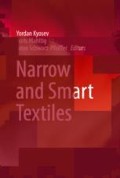Abstract
Textile materials and their modifications for use in bio-based fiber reinforced materials are presented. Main results are related to hydrophobic and antimicrobial functionalization, to make the natural fiber materials more suitable for application in composite materials. To realize a fully bio-based composite, it is the challenge to evaluated also bio-based finishing agents offering the wished properties.
Access this chapter
Tax calculation will be finalised at checkout
Purchases are for personal use only
References
Soutis, C. (2005). Fibre reinforced composites in aircraft construction. Progress in Aerospace Sciences, 41, 143–151.
Trimble, B.J. (1989). Composite bicycle frame and production method US Patent, US4,850,607.
Cherrington, R., Goodship, V., Meredith, J., Wood, B. M., Coles, S. R., Vuillaume, A., et al. (2012). Producer responsibility: Defining the incentive for recycling composite wind turbine blades in Europe. Energy Policy, 47, 13–21.
Thakur, V. K., & Thakur, M. K. (2014). Processing and characterization of natural cellulose fibers/thermoset polymer composites. Carbohydrate Polymers, 109, 102–107.
Wambua, P., Ivens, J., & Verpoest, I. (2003). Natural fibres: can they replace glass in fibre reinforced plastics? Composites Science and Technology, 63, 1259–1264.
Schürmann, H. (2005). Konstruieren mit Faser-Kunststoff-Verbunden. Berlin: Springer-Verlag.
Bogoeva-Gaceva, G., Avella, M., Malinconico, M., Buzarovska, A., Grozdanov, A., Gentile, G., et al. (2007). Natural fiber eco-composites. Polymer Composites, 28, 98–107.
Pico, D., Wilms, C., Seide, G., & Gries, T. (2011). Natural volcanic rock fibers. Chemical Fibers International, 61, 90–91.
Larsen, K. (2009). Recycling wind turbine blades. Renewable Energy Focus, 9, 70–73.
Behr, D. (1991). Wirkerei und Strickerei Technik, 41, 7.
Textor, T., & Mahltig, B. (2010). A sol-gel based surface treatment for preparation of water repellent antistatic textiles. Applied Surface Science, 256, 1668–1674.
Erdumlu, N., & Ozipek, B. (2008). Investigation of regenerated bamboo fibre and yarn characteristics. Fibres & Textiles in Eastern Europe, 16, 43–47.
Kick, T., Grethe, T., & Mahltig, B. (2017). A Natural Based Method for Hydrophobic Treatment of Natural Fiber Material. Acta Chimica Slovenica, 64, 373–380.
Allen, S. (2011). Oberflächenbehandlung von Holz. Vincentz Network GmbH, Hannover: Klassische Techniken und Rezepte.
Schönemann, A., Eisbein, M., Unger, A., Dellmour, M., Frenzel, W., & Kenndler, E. (2008). Historic Consolidants for Wooden Works of Art in Saxony. Studies in Conservation, 53, 118–130.
Trueb, L. F. (2015). Pflanzliche Naturstoffe. Stuttgart: Borntraeger Verlagsbuchhandlung.
Grethe, T., Kick, T., & Mahltig, B. (2017). Sustainable controlling of hydrophilic properties of cotton and linen by application of amino acids. The Journal of the Textile Institute, 108, 436–439.
Martel, B., Weltrowski, M., Ruffin, D., & Morcellet, M. (2002). Polycarboxylic acids as crosslinking agents for grafting cyclodextrins onto cotton and wool fabrics: study of the process parameters. Journal of Applied Polymer Science, 83, 1449–1456.
Mahltig, B., Reibold, M., Gutmann, E., Textor, T., Gutmann, J., Haufe, H., et al. (2011). Preparation of silver nanoparticles suitable for textile finishing processes to produce textiles with strong antibacterial properties against different bacteria types. Zeitschrift für Naturforschung B Chemical Sciences, 66B, 905–916.
Acknowledgements
This work is supported by the programme “Zentrales Innovationsprogramm Mittelstand” of the German Federal Ministry for Economic Affairs and Energy.
Author information
Authors and Affiliations
Corresponding author
Editor information
Editors and Affiliations
Rights and permissions
Copyright information
© 2018 Springer International Publishing AG
About this chapter
Cite this chapter
Grethe, T. et al. (2018). Fibers and Textiles for Fully Bio-Based Fiber Reinforced Materials. In: Kyosev, Y., Mahltig, B., Schwarz-Pfeiffer, A. (eds) Narrow and Smart Textiles. Springer, Cham. https://doi.org/10.1007/978-3-319-69050-6_4
Download citation
DOI: https://doi.org/10.1007/978-3-319-69050-6_4
Published:
Publisher Name: Springer, Cham
Print ISBN: 978-3-319-69049-0
Online ISBN: 978-3-319-69050-6
eBook Packages: Chemistry and Materials ScienceChemistry and Material Science (R0)

